In addition to growing white and black pines, Mr. Iwakiri has a fondness for deciduous trees – chojubai in particular.
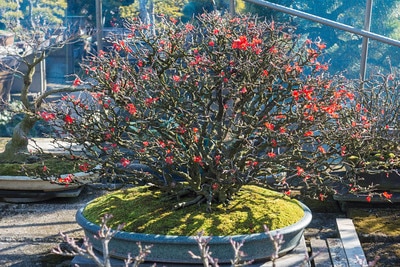
Japanese flowering quince – chojubai
Iwakiri offered some details about how he’s developed these trees. Many of the clump-style specimens are actually bundles of cuttings from the same tree that have grown together for 20-30 years.
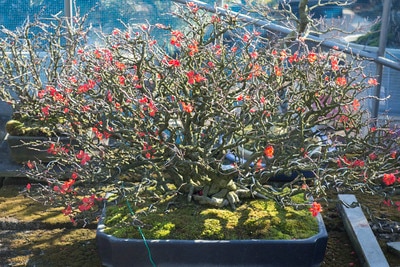
Cuttings grown together as multi-trunk specimen
How are they pruned? Three times a year, Iwakiri cuts new shoots back to two buds. He does this in June, August and October. In June, Iwakiri partially defoliates his chojubai by removing all but the interior leaves.
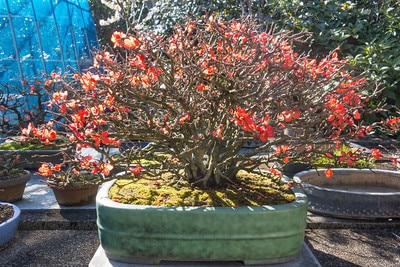
A full chojubai
The trees are repotted every 2 years. At repotting time, Iwakiri removes suckers as these often vigorous shoots can decrease the overall vigor of the tree. When he can take some root with the suckers, he uses them to start new trees.
Because lower branches are typically more vigorous than the highest branches, Iwakiri recommends removing the topmost growth when it gets too tall. Left unchecked, these branches can become weaker as they grow taller. When these branches are significant in size, he recommends making air-layers.
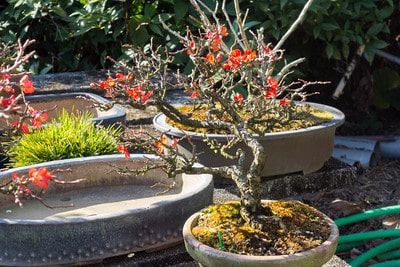
Chojubai made from air-layer
Young chojubai can also be planted over rocks.
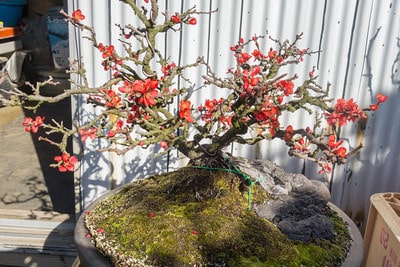
Root over rock chojubai
Across from Iwakiri’s chojubai were a selection of Japanese maples and Chinese quince, among other deciduous varieties. The blue screen-house is designed to keep pernicious beetles at bay.
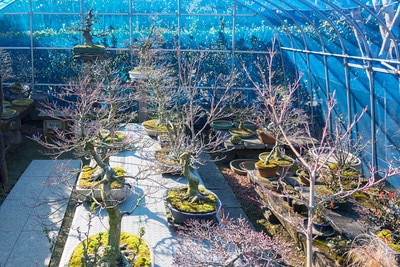
Japanese maples
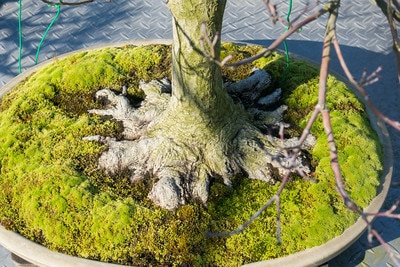
Japanese maple roots
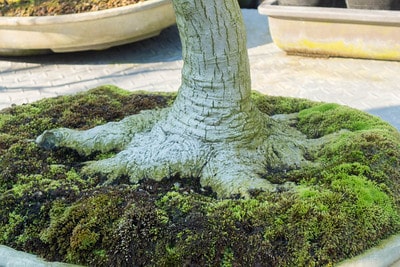
Iwakiri’s quince were no less interesting.
Japanese maple trunk and roots
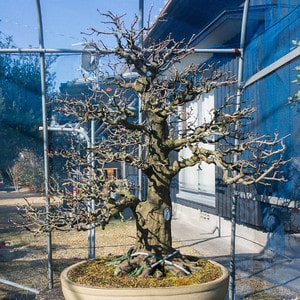
Chinese quince
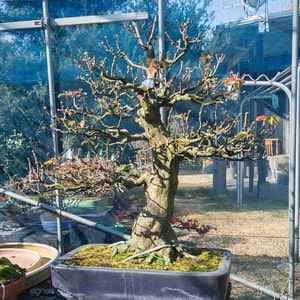
Chinese quince
Spending time with Mr. Iwakiri made me want to get home as soon as possible to put to use his many tips – the very best feeling I could hope to have after visiting such an inspiring garden.
Subscribe to Bonsai Tonight
New Posts Delivered Every Tuesday and Friday
nelibonsai says
I have several chojubai and one ROR another exposed root that is actually several trees fused together. Any guide lines on styling chojubai? I find it so confusing.
Jonas Dupuich says
Hi Neli – good question. The best starting point that comes to mind for styling chojubai is to see what others have done. Books from Japanese exhibits are one of the best places to look, and I’ll try to say more in future posts. In the meantime, Michael Hagedorn has posted a number of photos of chojubai done well, and you can search his site for more info about the variety.
http://crataegus.com/2011/12/22/chojubai-quince-diminutive-jewels/
http://crataegus.com/2013/03/25/the-joys-of-chojubai/
nelibonsai says
Thanks.
Alessandra says
Beautiful, I love them 🙂 amazing job
nelibonsai says
Thanks Jonas. I have seen Michael and your blog from top to bottom. I downloaded all his pictures too. Googled…checked all forums…but not much info.What I figure they are bushy clamp like…with moderately bent branches, that are not supposed to cross??? A bit like the top of a broom. Am I on the right truck? They look to me soooo messy, but a good looking mess. I am not sure if I should style the ROR and exposed root as other trees, or I am supposed to make them messy also. He he he!
nelibonsai says
Here are my funny chojubai: https://www.facebook.com/neli.stoyanova.180/media_set?set=a.10200673742918018.1073741911.1594227676&type=3
Paul says
Why can’t we get Chojubai in the UK? If anyone has a chojubai in the UK please get in touch – i’d love to have one. Great photos Michael – for an ‘amateur’ Mr Iwakari certainly has some killer trees.
Timothy says
“Iwakiri recommends removing the topmost growth when it gets too tall. Left unchecked, these branches can become weaker as they grow taller.”
With regard to the above comment, I believe this to be true for Chinese Quince also. I have left some tall branches go unchecked and they have ended up snapping under their own weight.
Another great article. Thanks so much.
don says
Are the Chinese Quince pruned and defoliated the same way as the Japanese variety? Thanks for keeping up your blog. Lots of good info.
Jonas Dupuich says
Hi Neli – I think “good looking mess” conveys the main idea. Yes, they can be much like the top of a broom-style tree but less formal (I’ll post more examples in the coming weeks). I’ll also add it to my list to talk more about branch structure for chojubai. Thanks for sharing the photos!
@Don – Chinese quince are treated differently, though I don’t have as much experience with them so I’d head to a forum (like bonsai study group) for advice about the differences.
Brian says
I notice that all the bonsai have moss on the soil, I thought that moss was just used for shows. Would it be a bad idea to put moss on my trees as well?
Jonas Dupuich says
Hi Brian – I think the moss just grew there. I’ve seen this in a number of gardens and it’s not necessarily a bad idea to keep moss on trees, though it makes more sense for some varieties/specimens than others (and there are more details here than I can properly understand or share). For trees that like extra moisture, a similar effect can be achieved by placing shredded sphagnum moss on the surface of the soil.
Brian says
Yeah I guess I could do that-I just like the look of the moss-I’ll have to see what I come up with
nelibonsai says
Thanks Jonas, Very kind of you…I took also lots of pictures when I was in Japan….must be over 20 000…while I did a bit of apprenticeship there…But ,looking is not the same as understanding certain principles in designing, and common denominators of the style…I have tried to figure it out and understand it…in order to apply it creatively, and in unique manner. If I dont have the understanding, it is hard to be creative. He he he! Your help will be greatly appreciated if you manage to figure it out.